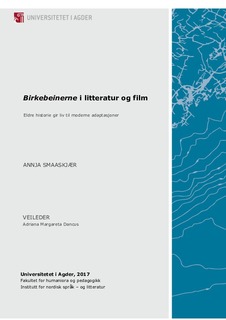| dc.description.abstract | In this master thesis, the movie (2016) and the book Birkebeinerne are reviewed through adaptation analysis to determine how the two completely different genres convey history. Essentially, the part of history that the two texts are adaptations of: (parts of) Håkon Håkonsson's saga. The main question is: How is this part of Norwegian history conveyed in two different adaptations?
It has been seen how the fact that they are adaptations can be decisive for the dissemination of history. Theory of adaptation is at the center of this thesis, but in order to give an fulfilling answer to the main question, it has also been necessary to supplement theory from the linguistic and literary sciences, such as communication and reception theory, semantics, semiology, language structure, norr language, history, etc. mentioning Linda Hutcheon, Norman Fairclough, Tzvetan Todorov, Jacob Lothe, Wenche Vagle, and others.
In relation to the book, the language structure, communication, reception and use of history have been in center of the analysis, as this was considered the most interesting in the analysis according to the adaptation process and the dissemination of history.
The film has been given more space in the project, as the film as a medium proved very interesting in the adaptation analysis because of its complexity and multimodality.
It is not the intention of this project to make a comparison between the two media or put them against each other. On the contrary, it has been interesting to look at what makes them special as adaptations and genres in relation to carrying out the dissemination of history.
The scriptwriter has also been interviewed in the project, which has provided an exciting approach, along with a selection of criticisms of the adaptations in the media. These are two opposites that act as conversation partners in the analyzes.
It is clear from the results of the analyzes that the intention and the desire behind the adaptations influence the outcome of how the different texts convey history. The same goes for the different medias’ conventions of genre. | nb_NO |

